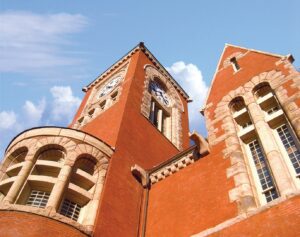
Amherst Town Hall. Self-described homeowners in this exclusive, ultra-liberal town are seeking to prevent apartment construction and densification.
What in the world is going on out in deepest blue Amherst?
A group of long-time residents and homeowners in the Western Massachusetts college town is pushing for a months-long moratorium on all new apartment projects.
Drawing their ire has been a flurry of new building, including plans for two new mixed-used projects downtown, with apartments above and retail below.
Now that would appear to be good news, given the growing housing affordability crisis that is gripping both our state and many parts of our country as well.
And Amherst is right in the thick of it. A highly desirable town to live in, it boasts some of the best public schools in the state. It is also home to both UMass Amherst and Amherst College.
The town’s desirability is reflected in its real estate prices. The median home price shot up 13 percent, to a median price of $445,000 in March according to The Warren Group, publisher of Banker & Tradesman. And 58 percent of apartment in town have rents of at least $1,500 or more a month, according to Rent Café.
Rents, even in the teeth of the pandemic, when most college students had gone home, rose 2 percent.
A Matter of Taste?
I guess it all depends on where you are coming from, but it’s hard to see how anyone could get worked up over the slate of new apartment buildings proposed for downtown Amherst.
Maybe they won’t win any awards for cutting edge architecture, but neither are we talking about Brutalist-style concrete apartment eyesores or 1970s-style, red-brick garden apartments.
Rather, these are fairly standard, modern-style apartment projects, not that much different from what you would see in the downtown of any Boston-area suburb.
We are talking buildings all of five stories tall, not skyscrapers.
Nor is anyone bulldozing historic downtown buildings or uprooting thriving little boutique shops are restaurants to make way for these new apartments.
The buildings are slated to replace a pretty ordinary looking, strip-center architecture, some seemingly half-empty, that are a dime a dozen along Route 9.
But apparently we are not going to see eye to eye here.
What to me look like unremarkable buildings are instead seen by this group of Amherst homeowners as the vanguard of an urban invasion.
New Rentals Called ‘Slum-Like’
The anxieties – and blinkered thinking – of the moratorium supporters were on full display during a recent Town Council meeting.
The meeting segued, with no comments on the potential irony, from a discussion of a town initiative aimed at making reparations for slavery to the moratorium on new rental construction.
Ira Bryck, a business coach and former head of the Family Business Center, made local headlines by using the loaded term “slum-like” to characterize his concern about new apartment construction in town.
Bryk later sent a letter to a local news website to complain he had been quoted out of context, though it’s your call whether the explanation makes anything better.
“The term ‘slum-like’ referred to the unwanted possible consequences of allowing many apartment buildings and triplexes in the neighborhoods around downtown,” Byrck wrote. “We are pointing out that ‘multi-family housing’ has also been euphemistic for deliberate overcrowding in inner cities.”
Another long-time resident, who moved to Amherst in 1971, warned councilors that “we don’t need an urban corridor many people think is pretty ugly to overshadow everything else.”
Self-described homeowner “Bob” feared a veritable invasion by multi-family housing developers of the city’s residential neighborhoods, with “knockdowns” willy-nilly of single-family homes.
“It sounds like a recipe to demolish neighborhoods,” he warned.
Students a Primary Target
Other supporters of the apartment moratorium – which would cover anything three units and up and last anywhere from six to nine months – questioned whether Amherst is truly experiencing a housing crisis.
These skeptics were a little hard to take, demanding town officials produce facts and figures to demonstrate the need for more apartments.
It had the feel of comfortably situated long-time homeowners, spared for years or even decades from the everyday realities of the housing market in Massachusetts.
One woman suggested surveying town residents to find out whether what their housing plans are – as if the new, privately built apartment buildings should somehow only serve Amherst residents, as opposed to filing housing needs more generally.
So, who are the good folks of Amherst, so politically correct in so many ways, trying to keep out of town?
Not surprisingly, students came up as a favorite target, with a frequent lament that the new apartment buildings wouldn’t bring in diverse families, but would rather be scooped up by student renters.
The complaints, in turn, seemed focused mainly on UMass Amherst, the flagship of the state’s public university system, as opposed to exclusive Amherst College.

Scott Van Voorhis
To which I say: So what? As is the case in Boston, Worcester or any other college town, a new apartment rented out by students will free up older rentals in other neighborhoods that currently serve as de facto off-campus housing.
Students teaming up to rent older homes regularly out-pay and out-compete middle- and working-class families with more constrained resources.
We need all the new apartments we can get in Massachusetts, especially in pricey, and frankly quite exclusive, towns like Amherst.
And the moratorium backers, who all seem like reasonably intelligent, well-intentioned people, need to find a more worthy cause to pour their energies into.
Scott Van Voorhis is Banker & Tradesman’s columnist; opinions expressed are his own. He may be reached at sbvanvoorhis@hotmail.com.




 |
| 
